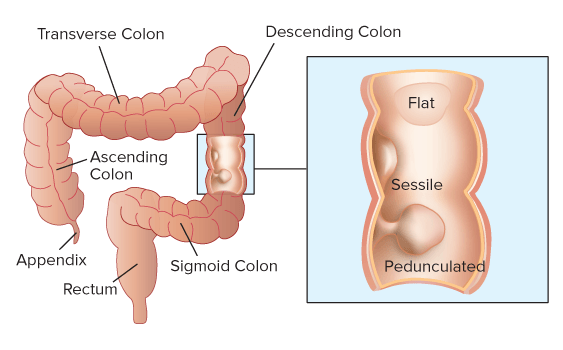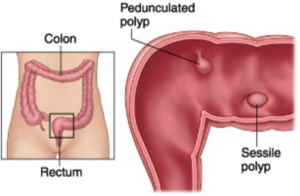Sessile Polyp
What is Sessile Polyp?
Sessile polyp are cells that grow inside your colon lining. Many of these colon polyps are benign but may become cancerous over time1.
Sessile polyp is a type of polyp without a stalk and is fixed to the lining of the colon by large base. This polyp affects the upper part of your colon and is not easily detected. Sessile polyp is precancerous and can become malignant over time5, 7.

Other types of colon polyps include: Polypoid polyps and flat polyps. Polypoid polyps look like mushroom and are joined to the lining by a slim stalk. Flat polyps are not common and they appear flat and slightly lowered.
Clinical Importance
Colon polyps can form cancer in your body. Colon polyps start as benign and can become cancerous over time. This is because of increased mutation which alters the genetic material in the colon cells. Colon polyps are vital because they help your doctor detect and prevent cancer in early stages.
Causes
Genetic factors
Polyps are formed when genetic material in the cells lining of the colon becomes defective. Changes in the genetic material hinder the cells from maturing and dying as they are supposed to.
The buildup of abnormal cells in the lining of the colon leads to formation of polyps.
Risk Factors
Any person can get colon polyp. Developing colon polyps is a result of a combination of genetic and environmental factors. The following can elevate the risk of colon polyps forming:
- Smoking
- Consuming diet that has low fiber
- Eating red meat
- Eating food with high fat
- Drinking alcohol
- Being obese or having a lot of weight.
Age is also considered to be a risk factor of colon polyps. People over the age of 50 years are more susceptible to sessile polyp.
Inherited Polyp Disorders
It is rare for people to inherit defective genes that form polyp. However, in case you have these mutated genes, you are at a higher risk of developing colon cancer. The following are examples of inherited disorders that may cause colon polyps:
- Lynch syndrome
- Familial adenomatous polyposis (FAP)
- MYH-associated polyposis (MAP)
- Gardner’s syndrome
Symptoms
Symptoms of colon polyps can be seen during screening. When you are suspected to have sessile polyps, your stool has red blood on the surface or mixed in it.
In some cases, people with sessile polyps may have black stool which is as a result of excessive bleeding and the polyp is situated in the ascending and cecum colon.
Patients with this polyp appear weak and faint easily. They also have pale skin and increased heart rate because of deficiency of iron in the body.
When to See your Doctor?
You can seek medical attention if you experience the following symptoms:
- You notice blood in your stool.
- Your stool becomes black.
- If your bowels last more than a week.

Diagnosis
There are several ways to diagnose colon polyps such as:
Endoscopic colonoscopy
This diagnostic test uses colonoscope that has a light and a camera. Your doctor inserts the colonoscope though your anus into the colon until cecum is reached. Colonoscope is then used to observe the colon for any abnormalities and polyps. Your doctor removes a sample of the tissue in your colon for analysis.
Virtual colonoscopy
This test uses CT scan to look into your colon. In case there is a polyp, colonoscopy will be used to remove it.
Treatment
Colon polyps can be removed through endoscope.
Endoscopic mucosal resection
For sessile polyps, an endoscopic mucosal resection (EMR) can be used. Endoscopic mucosal resection (EMR) is a method used to stage and treat tumors or neoplasm of the digestive system.
Endoscopic mucosal resection (EMR) is conducted with an elongated, thin tube that has a camera and light. There are several versions of endoscopic mucosal resection (EMR) such as injection-assisted, ligation-assisted and cap-assisted.
Cleaning the colon
Before undergoing endoscopic mucosal resection (EMR), your doctor will help you clean your colon. Your doctor may give you a liquid laxative or an over-the-counter enema kit to remove the entire stool in the colon. Presence of stool in the colon will obstruct your doctor from seeing the polyp.
Procedure of removing polyp
Once cleaning of the colon is finished, your doctor will insert the tube through your anus into the colon.
Then inject a liquid below the polyp to separate it from the surrounding tissues in order to remove it. The polyp is cut and separated from the healthy tissues and removed by wire snare.
Your doctor then marks the area so that it can be easily indentified in the next endoscopic exam.
This procedure can eliminate tissues that are in early stages of cancer and those that are precancerous.
Complications
Endoscopic mucosal resection (EMR) can cause the following side effects:
- It can cause bleeding on the walls of the colon.
- It can also puncture your colon walls depending on the size of the sessile polyp.
In some cases patients may develop other symptoms during and after endoscopic mucosal resection (EMR) such as
- Pain in the abdomen
- High temperatures or fever
- Changes in the stool color especially black stool
Call your doctor immediately if you experience the above symptoms.
Results of the test
Your gastroenterologist will schedule a follow-up session to discuss the results of the tests with you. Your doctor will be able to advice you accordingly based on the results.
Follow- up tests
Normally, your doctor may conduct follow-up test after one year. This is to ensure that the entire polyp was removed. The exam will involve the use of an endoscope to inspect the area of the removed polyp.
The doctor will advise you basing on the findings of the follow-up tests.

Prevention
The best option to prevent sessile polyps is to go for regular screening. This will help detect polyps early and remove them to prevent cancer from developing. Other ways of preventing colon polyps include:
- Minimize intake of fatty foods
- Stop smoking and limit drinking alcohol
- Exercise regularly.
Reference List
- Colon polyps. Available at http://www.mayoclinic.org/diseases-conditions/colon-polyps/basics/definition/con-20031957
- Endoscopic mucosal resection. Available at http://www.mayoclinic.org/tests-procedures/endoscopic-mucosal-resection/basics/results/prc-20014197
- Endoscopic mucosal resection. Available at http://emedicine.medscape.com/article/1891659-overview
- Colon polyps. Available at http://www.arizonadigestivehealth.com/wp-content/uploads/2012/11/Polyps-and-Cancer-Prevention.pdf
- Sessile colon polyp. Available at http://cancerworld.info/sessile-colon-polyp-cancer-treatment/
- Gastrointestinal endoscopy. Available at http://www.gastros.com.au/downloads/Sessile_Serrated_Polyps.pdf
- Sessile serrated polyps. Available at http://diagmed.healthcare/wp-content/uploads/2015/05/Cleveland-Clinic-Journal-of-Medicine-2012-MAKKAR-865-71.pdf
